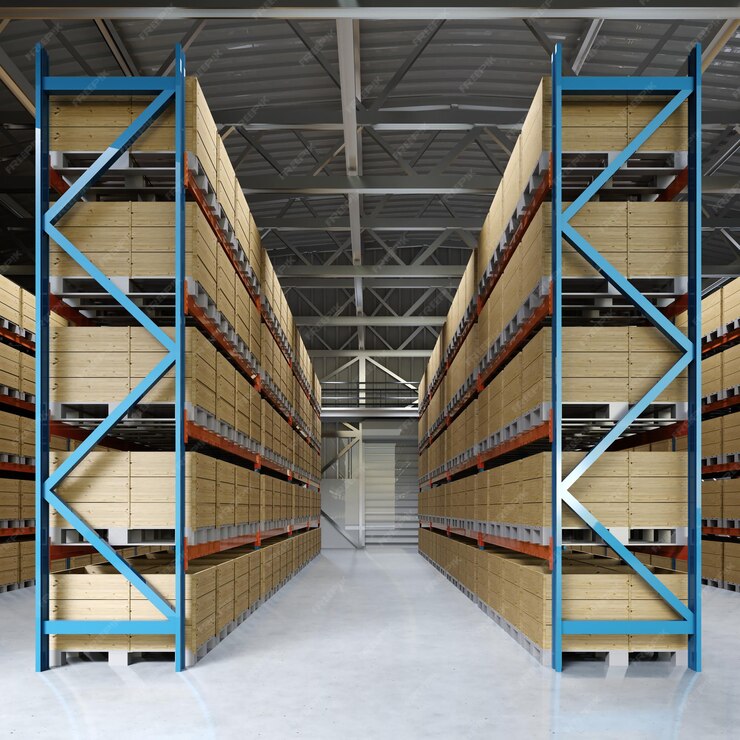Rack Supported WareHouse

A Rack-Supported Warehouse is a type of storage solution in which the building's structure, including the roof and walls, is supported by a racking system rather than traditional columns or structural supports. In this system, the racks themselves serve as the primary structural framework for the warehouse, supporting both the storage load and the overall building structure. This innovative design maximizes vertical storage space, improving storage density while reducing the need for additional structural elements.
How Rack-Supported Warehouses Work:
In a rack-supported warehouse, the racking system is designed to handle both the storage of goods and the structural load of the building. The key components of this system include:
Racking System: The racking system forms the core of the building's structure. It typically consists of high-density shelving or pallet racks arranged in rows to store goods. The racks are built to bear the weight of not just the stored materials, but also the roof and other components of the building.
Roof and Walls: Instead of relying on traditional support columns or beams, the roof and walls of a rack-supported warehouse are directly supported by the racking system. The roof is usually lightweight and can be constructed with materials that reduce the overall weight and cost.
Flooring: The warehouse floor is typically designed to support the heavy loads from the stored goods and the racking system. It may also have reinforced areas to ensure that it can handle the additional weight of the racks and products.
Aisles and Access: The warehouse layout is designed to allow for efficient access to the racks. A narrow aisle design is often used to maximize storage space, with automated or manual equipment used for retrieval and placement of goods.
Advantages of Rack-Supported Warehouses:
Maximized Storage Space: Since the racking system supports the structure, more space can be used for storage instead of leaving room for traditional support columns. This allows for a higher density of storage and better utilization of vertical space.
Cost-Effective: Rack-supported warehouses can be more economical to build compared to traditional warehouses with columns, beams, and other structural elements. The use of the racking system as both storage and structural support can reduce construction costs and materials.
Flexibility: The design allows for flexibility in storage and handling of goods. The racking system can be customized to suit specific products, whether they are pallets, shelves, or other types of goods.
Efficient Use of Space: The layout of the warehouse can be optimized for high-density storage, with narrow aisles and high racks, which helps to make the most of the available space.
Faster Retrieval and Stock Rotation: Rack-supported warehouses can be designed to improve the flow of materials, facilitating faster retrieval and stock rotation, especially when integrated with automated systems like conveyors or automated guided vehicles (AGVs).
Less Need for Additional Infrastructure: Since the racking system supports the warehouse structure, there is no need for additional columns, beams, or other support elements, freeing up valuable floor space for storage or operational activities.
Disadvantages of Rack-Supported Warehouses:
Complex Design: The design and construction of a rack-supported warehouse require careful planning and engineering. It must ensure that the racking system can safely support the weight of both the goods and the building’s structural components.
Higher Initial Investment: While the long-term benefits may be significant, the initial investment in designing and building a rack-supported warehouse can be higher due to the specialized equipment and materials needed for the racking system.
Limited Modifications: Once a rack-supported warehouse is constructed, making modifications or changes to the structure can be more difficult and expensive than with traditional warehouses. Adding new racking systems or changing the warehouse layout may require significant engineering work.
Maintenance: The maintenance of the racking system and the building as a whole requires careful attention. Any damage to the racking system could potentially affect the structural integrity of the entire warehouse.
Applications:
Rack-supported warehouses are commonly used in industries that require high-density storage and efficient access to goods, including:
- Retail and E-commerce: Storing large volumes of products with fast retrieval times.
- Automotive and Manufacturing: For storing parts, tools, and materials in industrial environments.
- Cold Storage: For perishable goods that need to be stored in controlled environments.
- Logistics and Distribution Centers: Optimizing storage and retrieval processes for bulk goods.
Conclusion:
A rack-supported warehouse is an innovative solution that offers significant advantages in terms of storage efficiency and cost-effectiveness. By utilizing the racking system as both a storage and structural element, these warehouses maximize the use of available space and minimize the need for traditional support structures. While the design is more complex and requires careful planning, the long-term benefits make it an excellent choice for businesses looking to optimize storage density and reduce construction costs.